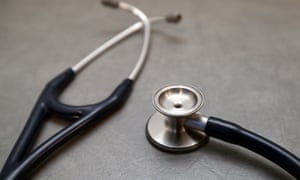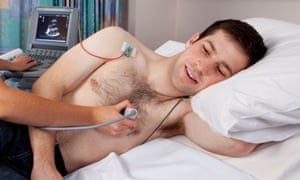Advances in Diagnostic Medical Tools
"I'm wearing my father's. He was also a cardiologist. He gave it to me when I graduated from medicine."
"You'll always have to rely on what you hear. And sometimes with a stethoscope you get everything you need."
"The stethoscope has more of a unique value [than technologically advanced pocket-sized ultra sound scanners and echocardiograms] ... when you examine lungs and bowels. Currently no technology can replace that."
"Personally, I trained in Argentina. And I have seven years of medical school where, from the first day until the last day, we trained using the stethoscope. I think that's the key."
"Patients feel satisfaction and sometimes a better understanding of a disease when you put a stethoscope to the chest and you tell them what you're hearing. And I think there is an issue of ... the human touch, the human contact with patients and I think that strengthens the patient and doctor relationship."
Dr. Diego Delgado, cardiologist, University Health Network, Toronto

"The stethoscope is dead. The time for the stethoscope is gone."
Dr. Jagat Narula, cardiologist, Mount Sinai Hospital, New York
 |
| A patient undergoes an echocardiogram, with pocket-sized ultrasound devices, offering an electronic alternative to a stethoscope. Photograph: MediC Pix/Alamy |
"The stethoscope is very symbolic and sometimes it helps to build the physician's identity. When you wrap [it] around your neck as a physician, you have a sense of responsibility and identity ... and that's what we want our students to develop."In 1816, a French physician was examining a female physician but hesitated to place his head on her bosom to detect the rhythm of her heartbeat. Dr. Rene Laennec impulsively and ingenuously rolled paper into a conical tube, passing it to her reluctant colleague so he could place one end on her chest, the other to his ear to amplify the sound of her heart and thus make a stab at a diagnosis to complete his examination. She went on later to refine the device which became the stethoscope, used since then by doctors as a critically important tool.
"To train [as] a generalist, you need to know how to use a stethoscope as a basic tool."
Dr. Marcus Law, faculty of medicine, University of Toronto
According to Dr. Delgado, committed to the continued use of the stethoscope, favouring it hugely over the new medical technologies now available, "the stethoscope and tongue depressor" remain the basic and often only tools that many physicians have at their disposal to aid them in their examination of patients presenting with symptoms that require evaluation. "So you need to really know how to use it", he concluded. Dr. Law at the faculty of medicine, University of Toronto, concurs.
 |
| Dr. Diego Delgado, a cardiologist at Toronto’s University Health Network, wears the stethoscope given to him by his father, also a cardiologist. Delgado notes that a stethoscope is also uniquely useful in examining other organs, such as lungs and bowels. Lucas Oleniuk / Toronto Star |
As far as he is concerned, there is the symbolic importance of the stethoscope to be sure; when a physician wears one it is as though it is a proud symbol of their professional status. More than that, he foresees that this basic tool whose value has been proven is destined to remain an important diagnostic tool, in particular for those medical students planning to enter general practise. "Even if we have [other] technology, it's not that widespread", confides Dr. Law.
And there are new-generation stethoscopes whose improved functions will continue to ensure that the tool remains an invaluable part of the medical professional's arsenal of tools in his little black box. Electronic versions capable of transmitting heart sounds to remote computers. Algorithms are then able to parse them to recommend possible diagnoses. Apart from these new upgrades for the mainstay stethoscope, there are additional tools making their way into use by cardiologists for which they are abandoning the stethoscope as outdated.
New-generation medical devices such as pocket-size echocardiograms and ultrasound scanners capable of producing pictures of the beating heart, charting its rhythms as it pumps away, with the doctor beside the bed of the patient, for example. What these new tools do as far as some medical professionals are concerned, is shorten the time used for diagnostic procedures, and enhance the probability of more accurate diagnoses.
There is less fine training and time devoted required to ensure a doctor is able to detect and parse the signals given by a stethoscope. Doctors' diagnostic skills for listening, known as auscultation, which once was a requirement before graduating from medical school would not be as critical in their development with the use of the newer technology and the setting aside of the stethoscope.
And this is what Dr. Narula of Mount Sinai Hospital stresses; with the emergence of these hand-held devices which electronically chart the heart's rhythms, detecting murmurs and other irregularities, the stethoscope becomes redundant, skills in its use no longer required.
Many in the medical profession deplore the fact that doctors are reluctant to set aside their reliance on stethoscopes and take up the use of the new medical devices which they insist are superior in function and capability to the stethoscope; doctors, they fume, detest change, preferring to cling to what they're familiar with, to the detriment of efficiency and accuracy.
Others, to the contrary, argue that few physicians are able to accurately interpret heart sounds which are amplified into their ears through the rubber tubing of the stethoscope. In fact, studies in the last few decades have pointed to a low percentage of young doctors able to identify many of the common heart ailments with the use of stethoscopes alone.

0 Comments:
Post a Comment
<< Home